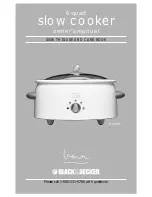
The oven
20
Defrosting
Set the function control to
. When thawing frozen
meat, fish, glazed, iced or filled bakery products, the
temperature control should be off.
Oven shelves/baking trays can be placed on several
shelf positions if you have a large quantity of food to
defrost. The times required cannot be given here. Test
using a skewer.
Cleaning and maintenance
The oven
The oven surfaces are of vitreous enamel. The outer
section, the door front, can easily be removed for
cleaning (see “The oven door” below).
IF
THE
OVEN
IS
VERY
SOILED
:
1
Use a spatula or similar implement to remove
spillages which have hardened.
2
Use a sponge to spread soft soap inside the oven.
3
Close the door. Set the oven to
(top/bottom
heat) and 100°C for about 10 minutes.
4
When the oven has cooled, wash the surfaces
with clean water. Rub gently with a soapimpreg-
nated steelwool pad on stubborn patches. Wipe
the surfaces dry.
The oven door
The oven door consists of two sections with heat-
reflecting glass for a lower surface temperature. Do
not scratch the class when cleaning, it has a heat-
reflecting layer on the inside.
TO
CLEAN
BETWEEN
THE
TWO
PANES
:
1
Check that the oven is not hot, then slide the
storage drawer open.
2
Open the door and insert (for example) rolled-up
oven cloths between the hinges
(
SEE
PICTURE
)
.
These are to prevent the door from closing.
3
Hold the inner section of the door down (to pre-
vent it from springing up when released), then
use a coin or suitable screwdriver to undo the
two screws
(
SEE
PICTURE
)
.
4
Carefully raise the inner section of the door and
clean the panes (use a product for window-
cleaning). If the glass is very soiled, use the
scraper supplied with the cooker.
5
When you have finished cleaning, hold the inner
section of the door in its original position, refit and
tighten the screws, and remove the oven cloths.
2
2
1
4
3









































